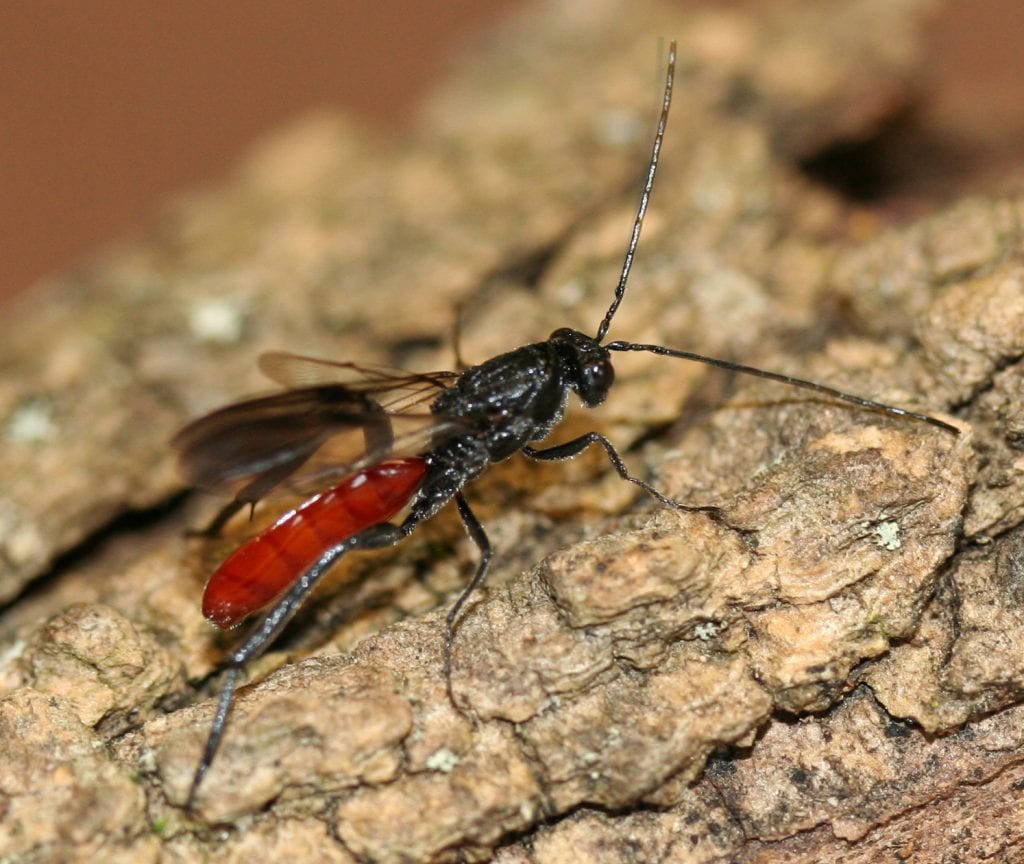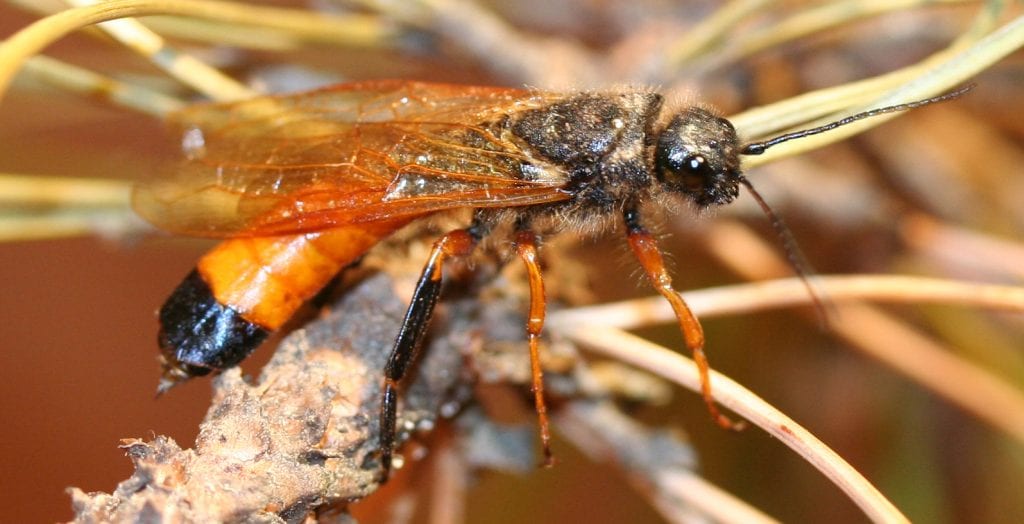Invasive versus Native Woodwasp Interactions with Symbionts and Parasites

Sirex noctilio was first collected from an established population in North America in 2004 in Fulton, New York, near Lake Ontario. This woodwasp is primarily associated with pine trees. It originated in Eurasia and was introduced to areas in the Southern Hemisphere during the last century. Pines are not native in the Southern Hemisphere but have been introduced and are grown in plantations, e.g., New Zealand, Australia, South America (Uruguay, Argentina and Brazil) and South Africa. It has also been introduced to northeastern China, where it was first being reported in 2013.
Although Sirex is not known as a pest in its native range, it has caused extensive mortality of pine trees in the Southern Hemisphere. This is in part due to the obligate, mutualistic white rot fungus, Amylostereum areolatum that always accompanies S. noctilio. The woodwasp injects trees with a venom that weakens tree defenses allowing the fungus to spread within the tree. This combination of venom plus fungus can kill pines (especially those that are already weak), giving this woodwasp the reputation of being the most aggressive and pestiferous among all siricids.

When this woodwasp/fungus complex was wreaking havoc in Australia in the 1970s-1980s, a major biological control program was undertaken. Many hymenopteran parasitoids of Sirex were found and some were introduced. However, it was generally agreed that a newly discovered parasitic nematode, Deladenus siricidicola, that sterilizes female S. noctilio, provided the best control. This nematode was first discovered and described from a forest in Hungary and is now considered the most important biological control agent for S. noctilio. It is dimorphic; the nematode can be one of two forms with notably different physical characteristics. One is mycophagous and feeds on Amylostereum and the other is parasitic and inhabits Sirex. The strain of D. siricidicola developed for biological control sterilizes adult females by invading and killing eggs within the adult. These nematodes have been used extensively for biological control in Southern Hemisphere pine plantations infested with S. noctilio and can be purchased today from a company in Australia.
After S. noctilio was discovered in North America, questions were raised about whether D. siricidicola should be used for its control. This was the first time that this invasive woodwasp had been found in areas where there were native Sirex, fungus, and nematode species. Relatively little was known about these native woodwasp/fungus/nematode systems in North America, but researchers and land managers felt it was important to understand them more fully before embarking on nematode-based biological control regimes in order to ensure that the native biodiversity would not be negatively impacted.
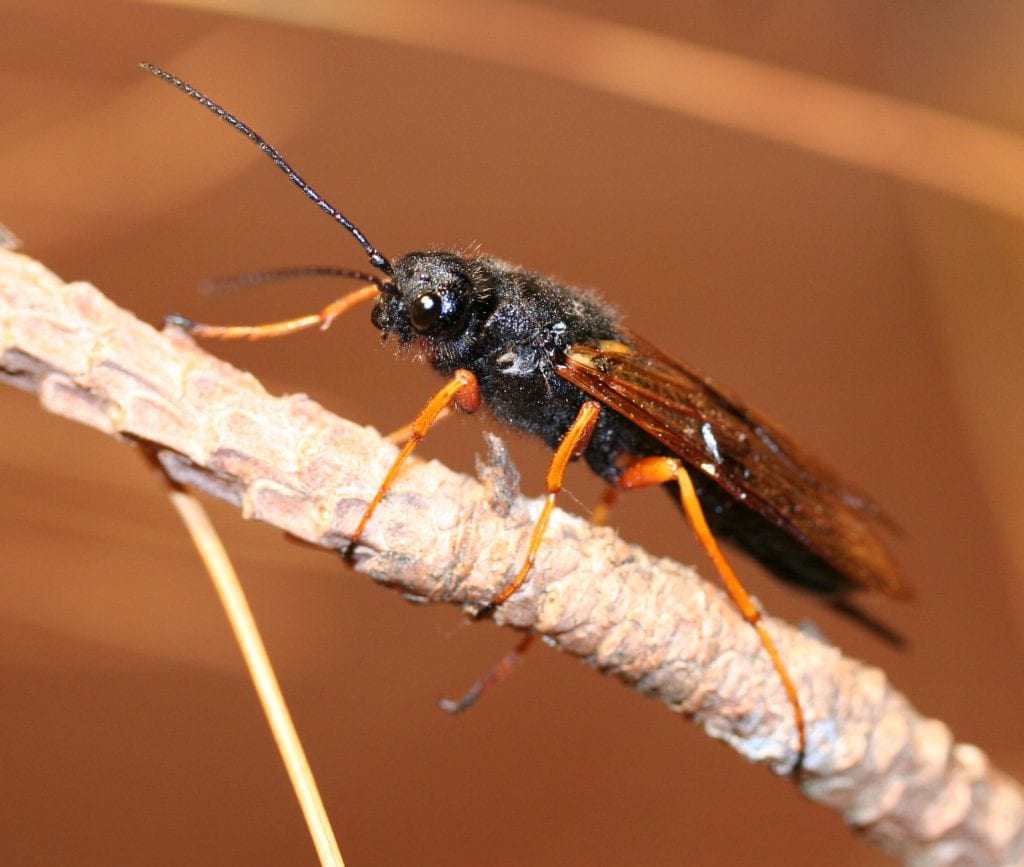
Below are different aspects of the invasive and native members of this triad that have been investigated by our laboratory group. This very brief summary will be organized by the main member(s) of the triad that were investigated. We’ve tried to mention these papers under the section that makes most sense but there is a lot of cross-over among some of the papers, e.g., papers about mycophagous stages of Deladenus could be either under the fungus or the nematode sections. Therefore, please look in both places.
Review paper
Hajek, A.E., Morris, E.E. 2014. Biological control of Sirex noctilio. In (R.G. Van Driesche & R. Reardon, eds.) The Use of Classical Biological Control to Preserve Forests in North America. FHTET-2013-02. USDA Forest Service, Forest Health Technology Enterprise Team, Morgantown, West Virginia. pp 331-346 [Invited review].
I. Sirex noctilio
- Using microsatellites to evaluate Sirex noctilio in North America, we determined that noctilio was introduced to North America at least twice. We were interested in the genotypes of this invasive woodwasp that are present in North America because different strains of S. noctilio can have different responses as to whether they are sterilized or not by different nematode strains and species. One of the genotypes of S. noctilio that is present in North America is potentially more virulent in killing pine trees. We also found that within single trees, there could be 2-15 families (siblings from the same mother) of S. noctilio (Bittner et al. 2017).
- Sirex noctilio will only mate when indirectly exposed to bright sunlight (few clouds) and warm temperatures. These responses occurred when single females were caged with groups of 10 males (Caetano & Hajek 2017).
- We became aware that we were having trouble finding the native pine-preferring Sirex nigricornis in the northeastern North America. We compared sizes of adults, venom glands, fecundity, tree species use, voltinism, and abundance of the invasive woodwasp noctilio with the native S. nigricornis in northeastern North American pines. Sirex noctilio has some functional characteristics that could give it a competitive advantage over the native Sirex nigricornis.
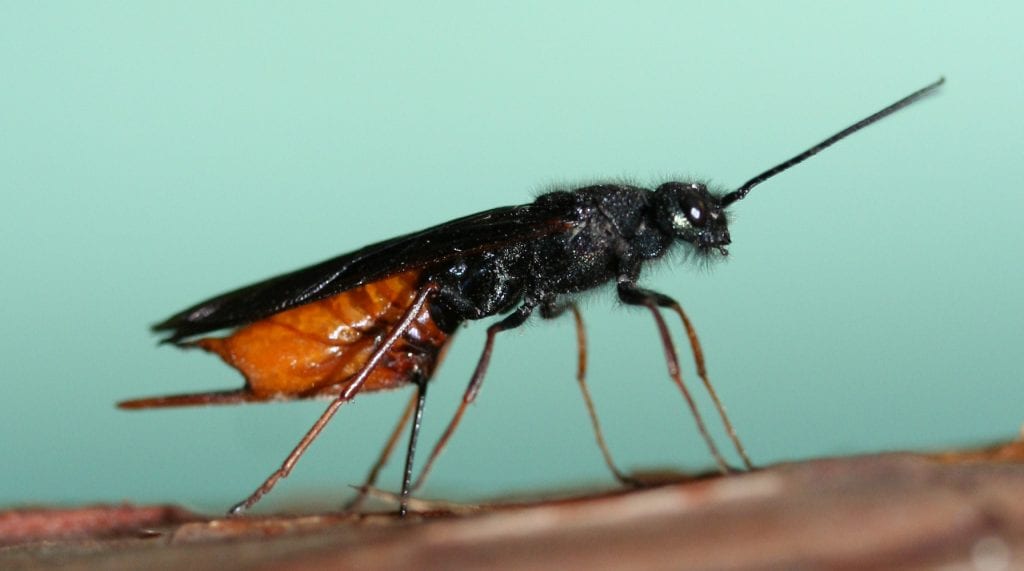
Sirex nigricornis (female), native in North America. Adults of the invasive S. noctilio were larger than S. nigricornis, female S. noctilio had larger glands carrying phytotoxic venom in relation to body size, average-sized S. noctilio females carried more eggs, and S. noctilio developed faster than S. nigricornis (and emerged much earlier each year). Sirex noctilio was the dominant woodwasp infesting suppressed pines in our study areas, and we hypothesize that it is outcompeting S. nigricornis, at least in trees considered acceptable by both species (Hajek et al. 2017).
- It is difficult to trap Sirex noctilio. We compared three types of traps with and without kairomone lures. Intercept traps baited with light were more attractive than the commercial kairomone lure (Sarvary et al. 2015).
- We tested attraction of Sirex noctilio to two species of white rot fungi Amylostereum (the noctilio-specific symbiont A. areolatum and the white rot often used by Sirex nigricornis, A. chailletii). Fewer unmated than mated females responded to either of the fungi and mated S. noctilio females were attracted to A. areolatum, although they did not avoid A. chailletii completely (Sarvary et al. 2016).
Bittner, T., Hajek, A.E., Haavik, L., Allison, J., Nahrung, H. 2017. Multiple introductions of Sirex noctilio (Hymenoptera: Siricidae) in northeastern North America based on microsatellite genotypes, and implications for biological control. Biological Invasions 19: 1431-1447.
Caetano, I.A.L., Hajek, A.E. 2017. Mating behavior and sexual receptivity of Sirex noctilio (Hymenoptera: Siricidae). Annals of the Entomological Society of America 110: 276-280.
Hajek, A.E., Henry, J.C., Standley, C.R., Foelker, C.J. 2017. Comparing functional traits and abundance of invasive versus native woodwasps. Neobiota 36: 39-55.
Sarvary, M.A., Cooperband, M.F., Hajek, A.E. 2015. The importance of olfactory and visual cues in developing better monitoring tools for Sirex noctilio. Agricultural and Forest Entomology 17: 29-35.
Sarvary, M.A., Hajek, A.E., Boröczky, K., Raguso, R.A., Cooperband, M.F. 2016. Investigating the effects of symbiotic fungus on the flight behavior of Sirex noctilio (Hymenoptera: Siricidae). Canadian Entomologist 147: 543-551. (doi:10.4039/tce.2016.10).

II. Symbiotic Fungus: Amylostereum spp.
-
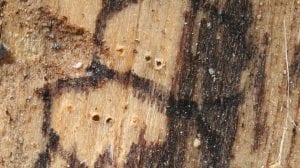
Sirex oviposition holes in a pine log (circled in ink for counting), visible on the outer wood surface after the bark was removed. We conducted experiments to investigate acceptance vs avoidance by female noctilio and S. nigricornis of native and non-native Amylostereum strains and species during ovipositor drilling in pines (Hajek et al. 2018). S. noctilio preferred wood without prior fungal emplacement, while S. nigricornis preferred wood inoculated with one of the strains of A. areolatum that putatively invaded with S. noctilio (an example of symbiont spillover). Drilling was highly aggregated for both species (Hajek et al. 2018).
- North American native woodwasps in the genus Urocerus are also associated with species of symbiotic white rot fungi. We found that sometimes females of the native species albicornis or U. cressoni carried a strain of A. areolatum putatively introduced to North America with S. noctilio, suggesting symbiont spillover (Hajek et al. 2017).
-

Deladenus nematode egg killed by fungus, with hyphae of Amylostereum visible inside. This fungus, which is eaten by the juvenile and adult nematodes, is also necessary for wood digestion for Sirex woodwasp larval nutrition. Photo © E. E. Morris.
Deladenus have forms that feed on Amylostereum but we reported, for the first time, that sometimes the fungus feeds on the nematodes. Two species of Amylostereum were investigated attacking three species of Deladenus. This occurs when fungal hyphae invade and kill nematode eggs, and the fungal hyphae can also physically entangle and kill adult female nematodes (Morris et al. 2014).
- We investigated fungal associations with different Sirex species in northeastern North America. It had previously been assumed that Sirex had strict species-specific relationships with either Amylostereum areolatum or chailletii. Instead, we found that two of the North American Sirex were found associated with either of these fungal species, which dispelled the assumption of strict fidelity. We also found horizontal transmission introduced strains of A. areolatum putatively introduced with S. noctilio to the native S. nigricornis (Hajek et al. 2013).
- In 2009, we reported that two genotypes of areolatum (based on IGS) were associated with invasive S. noctilio in North America, which potentially suggested two introductions. A strain of Amylostereum areolatum had been reported from North America, but this fungus had been found in association with a Sirex species that prefers spruce (in an area outside of the S. noctilio distribution), suggesting that some strains of A. areolatum are native to North America (Nielsen et al. 2009).
Hajek, A.E., Harris, D.C., Bittner, T.D. 2017. Symbiont spillover from invasive to native woodwasps. Microbial Ecology 75: 7-9. doi:10.1007/s00248-017-1018-7
Hajek, A.E., Nielsen, C., Kepler, R., Long, S.J., Castrillo, L. 2013. Fidelity among Sirex woodwasps and their fungal symbionts. Microbial Ecology 65: 753-762.
Hajek, A.E., Tobin, P.C., Kroll, S.A., Long, S.J. 2018. Symbionts mediate oviposition behavior in invasive and native woodwasps. Agricultural & Forest Entomology 20: 442-450. DOI: 10.1111/afe.12276.
Morris, E.E., Hajek A.E. 2014. Eat or be eaten: Fungus and nematode switch off as predator and prey. Fungal Ecology 11: 114-121.
Nielsen, C., Williams, D. W., Hajek, A.E. 2009. Putative source of the invasive Sirex noctilio fungal symbiont, Amylostereum areolatum, in the eastern United States and its association with native siricid woodwasps. Mycological Research 113: 1242-1253.
III. Nematodes: Deladenus spp.
Overall
- We described a new species of Deladenus from Sirex californicus collected in Washington State: Deladenus beddingi. The specimens of this species that emerged from pine were carrying chailletii (Morris et al. 2018).
- We investigated the diversity of Deladenus in Sirex species in northeastern North America. Our analyses suggest cospeciation between four North American Sirex spp. and their associated nematode parasites. We found crossover: the native nematode usually parasitizing S. nigricornis was found in S. noctilio and the introduced nematode usually found in S. noctilio parasitized S. nigricornis (Morris et al. 2013).

Morris, E.E., Kepler. R.M., Long, S.J., Williams, D.W., Hajek, A.E. 2013. Phylogenetic analysis of Deladenus nematodes parasitizing northeastern North American Sirex species. Journal of Invertebrate Pathology 113: 177-183.
Morris, E.E., Stock, S.P., Castrillo, L., Williams, D.W., Hajek, A.E. 2018. Characterisation of the dimorphic Deladenus beddingi n. sp. and its associated woodwasp and fungus. Nematology (early online). DOI: 10.1163/15685411-00003188
III. A. Deladenus – Parasitic Form

- The results of six years of experimental controlled release studies of the commercially available strain of siricidicola (Kamona), in which no nematodes were actually released into the field are presented. The non-sterilizing strain of D. siricidicola was already established in the area. Many of the Kamona-treated trees did not contain S. noctilio parasitized by Kamona; our hypothesis is that Kamona was potentially outcompeted by the non-sterilizing strain. However, even with Kamona treatments, little sterilization was observed. This suggests that the S. noctilio in North America is not easily sterilized by Kamona, in contrast with the S. noctilio found in Australia, where Kamona is used as a routine Sirex control method. We know from work by Bittner et al. 2017 (see above) that the genotypes of S. noctilio in North America are very different from the genotypes of S. noctilio present in Australia (Williams and Hajek 2017).
- We studied the effects of the invasive, non-sterilizing strain of siricidicola that putatively was introduced to North America along with S. noctilio. Although the non-sterilizing D. siridicicola did not sterilize, females were smaller and laid fewer eggs. We found these nematodes in 44% of trees and 26.9% of individuals diagnosed (Kroll et al. 2013).
- The melandryid beetle Serropalpus substriatus occupies the same pines that noctilio and Sirex cyaneus develop in. We found 0.7% parasitism of Se. substriatus by D. siricidicola. This was one of the first reports of non-target effects of D. siricidicola on native species (but the level of impact was very low) (Bittner et al. 2016).
Bittner, T., Hajek, A.E., Liebherr, J.K. 2016. Associations among Serropalpus substriatus (Coleoptera: Melandryidae) and Sirex (Hymenoptera: Siricidae) communities. Great Lakes Entomologist 49 (1-2): 19-26 (plus cover).
Kroll, S.A., Hajek, A.E., Morris, E.E., Long, S.J. 2013. Parasitism of Sirex noctilio by non-sterilizing Deladenus siricidicola in northeastern North America. Biological Control 67: 203-211.
Williams, D.W., Hajek, A.E. 2017. Biological control of Sirex noctilio (Hymenoptera: Siricidae) in the northeastern United States using an exotic parasitic nematode. Biological Control 107: 77-86.
III. B. Deladenus – Mycophagous Form
- The goal of one study was to compare reproduction of non-sterilizing siricidicola and D. siricidicola (Kamona) when feeding on four isolates of Amylostereum areolatum (three introduced and one native to North America) and one native strain of Amylostereum chailletii isolated from Sirex nigricornis. The mycophagous forms of the two D. siricidicola strains displayed similar reproductive rates when feeding on most of the A. areolatum found associated with S. noctilio in North America. Growth of both nematodes was greater on the introduced versus the native A. areolatum isolates (Caetano et al. 2016).
- A second study examined Deladenus proximus reproduction on different Amylostereum species and strains. This native nematode, originally known for parasitizing nigricornis, grew and reproduced when feeding on both A. chailletii and A. areolatum. The commercially available D. siricidicola (Kamona) grew on all strains of A. areolatum that were tested but grew mostly poorly on one of the strains of A. areolatum (D) it could encounter frequently in North America (Morris et al. 2014).
- We compared the growth of four isolates of areolatum on four types of artificial media. Growth occurred on all of the media tested, but after this study our lab decided to use PDA because it is reliable and easy to make. We then evaluated the ability of D. siricidicola to survive and increase on five isolates of A. areolatum and found that nematode populations persisted on all five isolates. Speed of growth of the fungus was negatively associated with production of nematodes (Morris et al. 2012).
Caetano, I.A.L., Morris, E.E., Hajek, A.E. 2016. Growth of the Sirex-parasitic nematode Deladenus siricidicola on the white rot fungus Amylostereum. Journal of Invertebrate Pathology 134: 12-14.
Morris, E.E., Hajek, A.E., Zieman, E., Williams, D.W. 2014. Deladenus (Tylenchida: Neotylenchidae) reproduction on species and strains of the white rot fungus Amylostereum. Biological Control 73: 50-58.
Morris, E.E., Jimenez, A., Long, S.J., Williams, D.W., Hajek, A.E. 2012. Variability in growth of Deladenus siricidicola on strains of the white rot fungus Amylostereum areolatum. BioControl 57: 677-686.
IV. Parasitoids

- Three hymenopteran parasitoid species emerged from pines occupied by Sirex noctilio and nigricornis, with an overall parasitism rate near 20%. Most of the parasitism was by Ibalia. The percentage of S. noctilio females emerging was positively correlated with wood diameter and percentages of parasitoids emerging were negatively correlated with wood diameter.
Long, S.J., D.W. Williams, A.E. Hajek. 2009. Sirex species (Hymenoptera: Siricidae) and their parasitoids in Pinus sylvestris in eastern North America. Canadian Entomologist 141: 153-157.
